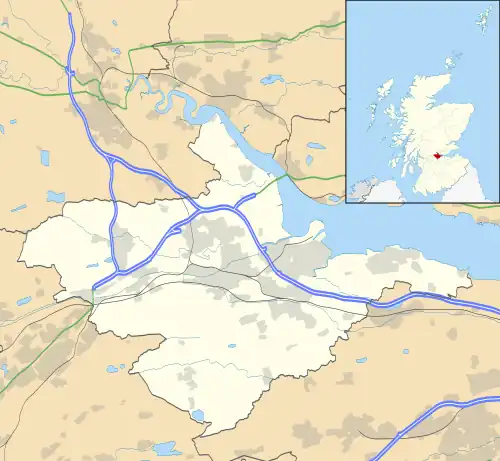Laurieston
| |
|---|---|
 Looking west towards Falkirk along the A803 through Laurieston | |
 Laurieston Location within the Falkirk council area | |
| Population | 2,650 (mid-2020 est.)[1] |
| OS grid reference | NS910794 |
| • Edinburgh | 21.8 mi (35.1 km) E |
| • London | 344 mi (554 km) SSE |
| Civil parish | |
| Council area | |
| Lieutenancy area | |
| Country | Scotland |
| Sovereign state | United Kingdom |
| Post town | FALKIRK |
| Postcode district | FK2 |
| Dialling code | 01324 |
| Police | Scotland |
| Fire | Scottish |
| Ambulance | Scottish |
| UK Parliament | |
| Scottish Parliament | |
| Website | falkirk.gov.uk |
Laurieston is a village in the Falkirk council area in Central Scotland. It is 1.5 miles (2.4 km) east Falkirk, 1.6 miles (2.6 km) south-west of Grangemouth and 1.6 miles (2.6 km) west of Polmont.
Laurieston is located on the A803 road between Falkirk and Polmont. At the time of the 2001 census, Laurieston had a population of 2,752 residents,[2] down from 3,000 in 1991 and 3,300 in 1971.[2]
The course of the Antonine Wall runs through the village with the largest fort on the wall located at Mumrills.
History
Laurieston was a planned village. Before Francis Napier, 6th Lord Napier, started feuing the lands of Langton in 1756, there was just a scatter of cottages and farmhouses. This new settlement was called New Merchiston after the Napier family seat. It was then renamed Lawrencetown in 1765 after Napier sold the project to Sir Lawrence Dundas, becoming known as Laurieston within a few years.[3] Situated on the main street is Hawthorn Cottage, a nineteenth-century stone dwelling that was once owned by Alfred Nobel, inventor of dynamite and creator of the Nobel Prizes after his death. Nobel lived there while managing an explosives factory near the nearby villages of Redding and Westquarter.[4]
Mumrills Fort, the largest Roman Fort on the Antonine Wall, was situated to the east while the path of the Antonine Wall runs through the village. The course of the wall runs roughly along Grahamsdyke Street, which is named after the wall's medieval name "Gryme's Dyke".[5]
Notable people
- John McAleese (1949–2011), British Army soldier, spent his childhood and youth in Laurieston.
.Captain James Fitz Morris MC ( Military Cross) 1879 - 1918 Royal Air Force flying ace Accredited with 14 Ariel Victories Attended Laurieston Public School Died in a flying Accident in Cincinnati USA 14th August 1918
.James Reilly MM (Military Medal) 1893 - 1918 The Royal Scots Lance Corporal James Reilly killed in France Recommended for his bravery on three occasions, he is honoured on the memorial at Arras to the missing in France. Brought up in James Street, Laurieston
Cheryl Forbes (Opera Singer) 1974 International operatic star Cheryl was born and brought up in Laurieston. She has taken the name of Laurieston all over the world with her singing. She has twice been honoured by her home town of Falkirk for services to music.
See also
References
- ↑ "Mid-2020 Population Estimates for Settlements and Localities in Scotland". National Records of Scotland. 31 March 2022. Retrieved 31 March 2022.
- 1 2 Insight 2001 Census, No. 3 – 2001 Census population of wards and settlements Archived 2011-06-03 at the Wayback Machine www.falkirk.gov.uk. Retrieved 2009-12-09
- ↑ Hood, John (2022). Old Polmont, Laurieston, Redding and Brightons. Catrine: Stenlake Publishing Ltd. p. 3. ISBN 978-1-84033-911-6.
- ↑ "Nobel in Scotland". Nobelprize.org, the official website of the Nobel Prize. 2010. Retrieved 6 October 2010.
- ↑ "Britannia, or, A chorographical description of Great Britain and Ireland, together with the adjacent islands". 1722.
External links